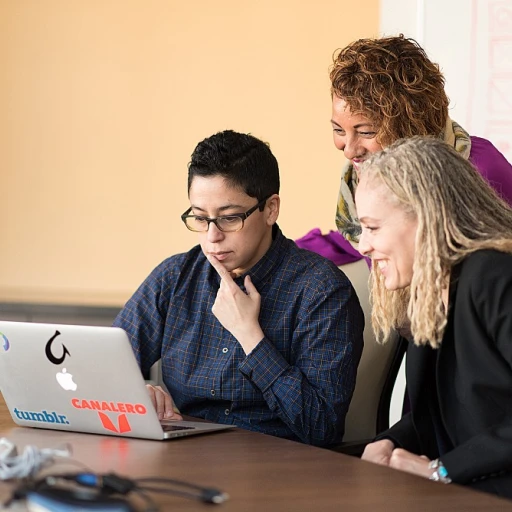Understanding the Importance of Team Building
The Critical Role of Team Building
Team building plays a pivotal role in fostering a collaborative and efficient workplace environment. When teams engage in activities that promote bonding and camaraderie, it can significantly enhance interpersonal communication and trust among team members. This is crucial for maintaining a productive work atmosphere. Incorporating regular team building exercises not only helps in strengthening relationships but also in developing problem-solving skills. This, in turn, contributes to creating a more harmonious office setting where employees find it easier to collaborate and innovate. Moreover, these activities serve as a great platform for individuals to discover and develop their unique skills, which can be beneficial for the team as a whole. Team members often find themselves in roles that require them to adapt and learn new skills quickly, fostering both personal and collective growth. By prioritizing team building in your workplace strategy, you'll not only help employees thrive individually but also collectively as a team. For more insights on this critical aspect of workplace dynamics, explore these innovative ways to enhance team cohesion. Effective team building should be inclusive, accommodating groups of varying sizes and dynamics. Whether it's through engaging games with a time limit or strategic problem-solving tasks, the key is ensuring every team member feels involved and valued. Team building activities aren't just for fun; they are essential tools for creating a cohesive and dynamic workforce.Types of Team Building Activities
Diverse Options for Team Building
Exploring different types of team building activities can significantly boost employee engagement and foster a positive work environment. Whether at the office or remotely, selecting the right activity tailored to your team’s needs is crucial.- Ice Breakers and Simple Games: For new teams or when welcoming new team members, start with simple activities like a short ice breaker game. These activities are great for small groups and require minimal time, typically 5-10 minutes, thus helping team members ease into more complex interactions.
- Problem-Solving Challenges: Activities that emphasize problem solving, such as escape room scenarios, can effectively improve collaboration and communication skills. These types of games encourage groups to solve problems together under a time limit, emphasizing collaboration and quick decision making.
- Outdoor Exercises and Scavenger Hunts: If logistics permit, an outdoor team building exercise like a scavenger hunt can introduce a fun, relaxed environment where teams can strengthen bonds outside the usual office setting. Such activities allow group members to explore creativity while reinforcing teamwork.
- Innovative Remote Activities: With remote work becoming more prevalent, engaging remote teams through virtual team building activities is equally necessary. Virtual trivia games, online quizzes, or digital escape rooms are fantastic options to maintain team bonding regardless of geographical constraints.
Implementing Team Building Activities Effectively
Strategies to Integrate Team Building Games into Your Routine
Implementing team building exercises effectively requires a structured approach to ensure participation and engagement from all team members. To achieve successful integration of these activities into your office environment or remote setup, consider the following strategies:- Identify Clear Objectives: Determine the specific goals your organization wants to achieve through team building games. Whether it is to improve communication skills, enhance problem-solving capabilities, or boost morale, having clear objectives will guide the selection of appropriate activities.
- Choose Suitable Activities: Select games that align with your objectives and consider the group size, time available, and team dynamics. For example, a fun scavenger hunt or an escape room can serve as great icebreakers for new team members, fostering a sense of unity and collaboration. You might find this resource on fun icebreaker activities useful for generating ideas.
- Ensure Inclusivity: To promote a collaborative environment, choose activities that can engage all team members, regardless of their physical abilities or level of comfort in social settings. Small groups may work better for shy individuals, allowing them to contribute without feeling overwhelmed.
- Allocate Appropriate Time: Ensure that there is adequate time within the work schedule for team building exercises. While the duration may vary from a few minutes to longer sessions, it is important to respect employees' time commitments by setting a clear time limit for each activity.
- Facilitate Active Participation: Encourage team members to participate fully by providing a supportive atmosphere. Leaders and managers should model engagement and enthusiasm, which will help in motivating others to join in the activities.
- Gather Feedback: After each session, solicit feedback from team members to assess what worked well and identify areas for improvement. Evaluating employee response paves the way for refining future team building activities, enhancing overall employee engagement. Consider crafting an effective needs assessment template to better understand ongoing and evolving team needs.
Overcoming Challenges in Team Building
Addressing Common Obstacles in Team Building
Navigating the challenges that can arise during team building activities requires foresight and a proactive approach. Even the most meticulously planned events can encounter issues that may hinder their effectiveness in enhancing employee engagement and teamwork. First, consider the diversity of your team members. Differences in personalities, backgrounds, and work styles can influence how individuals perceive and react to various team activities. It's essential to create a welcoming environment where everyone feels comfortable participating. One way to achieve this is by selecting building activities that are inclusive and accessible to all team members, regardless of their interests or physical abilities. Timing is also a crucial factor. Ensure that the scheduled activities do not conflict with critical work deadlines or personal commitments. This requires understanding the workload and priorities of your team to avoid potential stress or resentment from the participants. Opt for a time when most team members are available and can focus entirely on the activity. Additionally, logistical considerations like the size of the group and the space available can impact the success of your team building exercises. If dealing with larger teams, breaking them into small groups can enhance interaction and ensure everyone is engaged. For instance, a scavenger hunt or an escape room experience can be organized in smaller teams to foster collaboration and problem-solving skills. It's also important to address potential budget constraints. Creative solutions such as DIY building games or virtual activities can offer cost-effective alternatives that still promote team bonding and fun. Lastly, managing expectations is key. Team building should not be viewed as a one-time fix but rather as part of a long-term strategy to improve office dynamics. Transparent communication about the goals and potential outcomes can set realistic expectations and encourage ongoing participation from team members. By proactively addressing these challenges, companies can create a more harmonious work atmosphere where team building activities effectively contribute to building strong communication skills, fostering fun, and enhancing overall team cohesion.Measuring the Impact of Team Building Activities
Assessing the Outcomes of Bonding Activities
Measuring the impact of team building activities is vital for understanding their effectiveness in enhancing employee engagement and improving workplace dynamics. Different approaches can be used to evaluate these outcomes:
- Feedback Surveys: After the activities, team members can complete surveys to express their experiences and thoughts. This feedback gives insights into what worked well and what areas need improvement, which can help tailor future activities more effectively.
- Observation: Leaders and organizers should pay attention to group interactions during and after the team building exercises. Noticing changes in communication, problem solving, and collaboration skills among team members can indicate successful outcomes.
- Performance Metrics: Comparing performance indicators before and after engaging in team activities can provide concrete evidence of impact. This includes evaluating productivity, efficiency, and work quality, considering if building activities foster improvements in these areas.
- Team Morale: A general enthusiasm and positive vibe in the office can signal successful team bonding. Fun and engaging activities often lead to increased morale, where team members look forward to participating in future events.
The key to successful measurement lies in a combination of these methods, adapting them to fit the size and needs of your team or organization. Over time, organizations will be able to pinpoint what works best, ensuring that these activities foster genuine team bonding and strengthen office cohesion.












